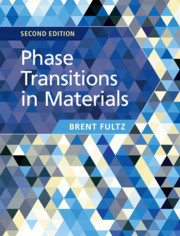Book contents
- Frontmatter
- Contents
- Preface
- Notation
- Part I Basic Thermodynamics and Kinetics of Phase Transformations
- Part II The Atomic Origins of Thermodynamics and Kinetics
- Part III Types of Phase Transformations
- 11 Thermodynamics and Phase Transitions at Surfaces
- 12 Melting
- 13 Solidification
- 14 Phase Transformations with Interfaces: 1. Microstructure
- 15 Phase Transformations with Interfaces: 2. Energetics and Kinetics
- 16 Spinodal Decomposition
- 17 Phase Field Theory
- 18 Method of Concentration Waves and Chemical Ordering
- 19 Diffusionless Transformations
- 20 Thermodynamics of Nanomaterials
- 21 Magnetic and Electronic Phase Transitions
- Further Reading
- References
- Index
18 - Method of Concentration Waves and Chemical Ordering
from Part III - Types of Phase Transformations
Published online by Cambridge University Press: 24 April 2020
- Frontmatter
- Contents
- Preface
- Notation
- Part I Basic Thermodynamics and Kinetics of Phase Transformations
- Part II The Atomic Origins of Thermodynamics and Kinetics
- Part III Types of Phase Transformations
- 11 Thermodynamics and Phase Transitions at Surfaces
- 12 Melting
- 13 Solidification
- 14 Phase Transformations with Interfaces: 1. Microstructure
- 15 Phase Transformations with Interfaces: 2. Energetics and Kinetics
- 16 Spinodal Decomposition
- 17 Phase Field Theory
- 18 Method of Concentration Waves and Chemical Ordering
- 19 Diffusionless Transformations
- 20 Thermodynamics of Nanomaterials
- 21 Magnetic and Electronic Phase Transitions
- Further Reading
- References
- Index
Summary
An ordered structure can be described as a static concentration wave, which varies from site to site on a crystal. Crests denote B-atoms and troughs denote the A-atoms, for example. A solid solution has zero amplitude of the concentration wave, so the amplitude of the concentration wave, η, serves as a long-range order parameter. With concentration waves, the free energy is transformed from real space to k-space. The concentration waves accommodate the symmetry of the ordered structure, and how it differs from the high temperature solid solution. A subtle analysis by Landau and Lifshitz shows that if a second-order phase transition is possible (i.e., the ordered structure evolves from the disordered with infinitesimal amplitude at the critical temperature), the translational symmetry of the free energy sets an elegant condition for the wavevectors of the ordered structure. Chapter 18 ends with a more general formulation of the freeenergy in terms of static concentration waves, which is an important example of how Fourier transform methods can treat long-range interactions in materials thermodynamics.
Keywords
- Type
- Chapter
- Information
- Phase Transitions in Materials , pp. 458 - 481Publisher: Cambridge University PressPrint publication year: 2020

